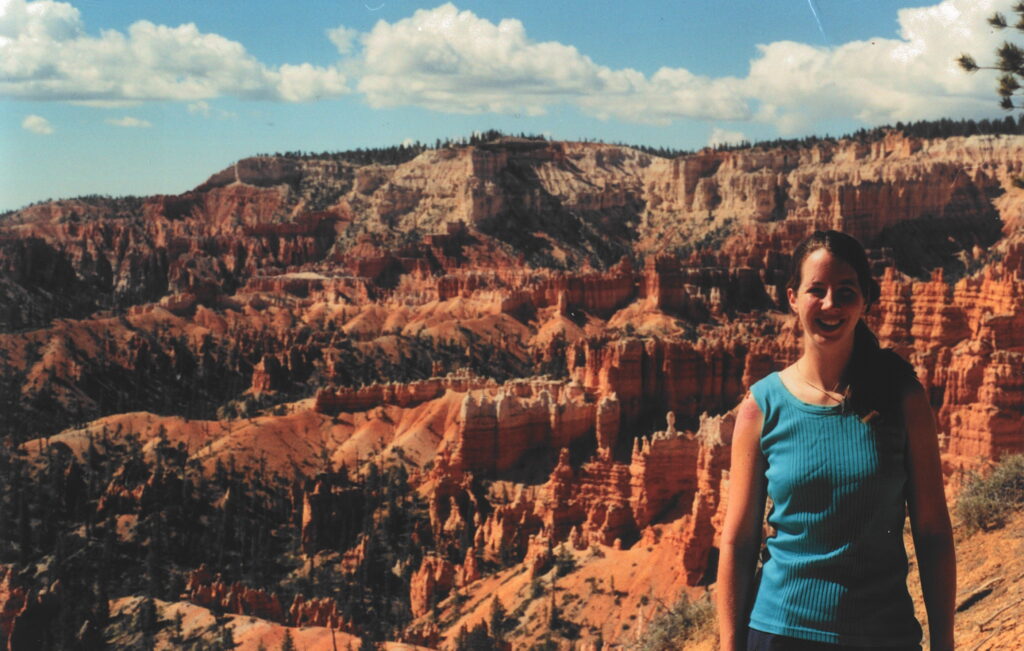
Ecologist Joslin A. Bennett’s passion for the outdoors led to an accident. Not one to let that scare her away from what she loves most, Bennett studied emergency medicine to help other people who get into trouble. She also teaches science and works to protect the environment from invasive plants and other problems.
Where are your favorite places you have been outside?
When a community has an urgent need for help, whether because someone has been hurt or because invasive plants threaten the environment, there might not always be experts at hand. In these kinds of situations, Ecologist and Middle School Science Teacher Joslin A. Bennett is the kind of person you want to have around.
During college, Bennett was certified as a first responder. Later, when she lived in Montana, she became certified in wilderness first aid, which taught her “what you do if somebody gets hurt in the backcountry.” She continued to pursue these topics, taking courses that helped her become a wilderness first responder and EMT. Over the years, she worked on ambulance crews and in search and rescue.
Bennett’s love for the outdoors had led her to study ecology and to work outside. Why did she add emergency medicine to her repertoire?

After graduating from college, Bennett worked at Bryce Canyon National Park, in Utah. She had her mountain bike shipped to her that summer. But because mountain biking wasn’t allowed in the park, she rode down to get her bike into a nearby national forest area. On the way, “something happened” and she “flew over the handle bars,” ending up with a crushed helmet and … unconscious. She “lay there unresponsive, not breathing.”
Luckily, “it just happened that the first person on the scene was a nurse practitioner from Florida,” who flipped Bennett over and opened her airway. She had a head injury but her spine was ok and she was life-flighted to Salt Lake City for medical treatment. The nurse called her parents and her father flew out from Pennsylvania to meet her at the hospital.
Once conscious again, Bennett never met the nurse practitioner who had saved her life. But she was able to pay her experience forward. Read to the end to find out how.
Born in Peterborough, New Hampshire, Joslin soon moved to Pennsylvania, near Maryland, so her father could teach science and math at a Baltimore school. She has an article taped to the wall in her office, whose headline she finds inspirational: “New Science Teacher is Amazing.” Her father’s inter-disciplinary, hands-on style of teaching was “very forward-thinking for the ‘70s.” Not only his students but also his daughter benefited: Joslin “would ask him for math problems to do for fun.”
Staying nearby, Bennett went to college at Baltimore’s Johns Hopkins University, where she took a class on geomorphology. Every week, the professor took students on a different field trip. They visited a stream bed, for instance, and “a huge road cut,” where they looked at the layers of rocks. “It was the best class” and inspired Bennett to major in environmental Earth science, a combination of geology and environmental engineering as well as Earth and planetary science.
At 22, eager to see more of the world, she joined the Peace Corps, which sent her to the South Pacific island of Niue, to do forestry work. Though she had not focused on trees and forestry in college, she was told that she was “the most qualified of the unqualified applicant pool.”
Niue, an island country of about 1200 people, is an atoll (an island formed partly by coral). When Bennett traveled there, the island was losing much of its population to New Zealand and Australia, creating a “brain drain” as college-educated children of the island settled in other countries. Niueans arranged to have Peace Corps volunteers come help them combat the spread of invasive plant species.
Bennett had done some GIS work as an intern. Geographic information system mapping technology uses computers to gather and map data. Your phone uses GIS to create the maps and map apps that help you get around. In Niue, Bennett used it to design a database for the island. It “was used to organize information about forestry land parcels that the government had leased from local landowners to plant exotic mahogany and red cedar. We kept records about how the trees were doing and the database was helpful to link spatial information with growth patterns.”
In addition to learning all she could about trees, Bennett also learned the local language and worked with land-owners to develop a national sustainable forestry plan. And she helped create a nursery that raised local species of plants — plants that would revitalize the island’s environment after years in which plantations had brought in exotic plants. Those exotic plants, including mahogany and red cedar trees, struggled on the atoll, which does not have much soil. Bennett encouraged people to focus on growing a different species of mahogany — a local species, which grew more easily on the island.
After two years on Niue, Bennett traveled, partly to go scuba diving in Australia and New Zealand, where she saw nudibranchs (colorful sea slugs): “They’re crazy-looking!” She also visited friends and family in Nepal and in Europe.
While hiking in New Zealand, she discovered that she had been accepted into the forestry program at the University of Montana, in Missoula. Coincidentally, soon after she got that good news, she met a hiker from Missoula who needed a house-sitter. What was the probability of that?
During graduate school, Bennett helped trap snowshoe hares in order to put radio collars on them and track their movements. The goal of that study was to help Canada lynx, whose favorite food is the snowshoe hare…. In addition to that work, she compared the responses of invasive weeds to methods of controlling them, including pesticides and carefully managed fires.
Fire also played a role in Bennett’s life after she graduated: she worked with Maine’s Nature Conservancy, clearing firebreaks in order to make it possible to burn blueberry barrens and areas where pitch pine scrub oaks live. “I love fire ecology,” she says, “it’s fascinating how ecosystems are adapted to fire.” “I love doing prescribed burning.” (In Bennett’s words, “fires are natural in the landscape.” Read here about how useful well-managed fire can be for the environment.)
After returning to Montana, she worked at a fire lab in Missoula, dating past fires based on evidence found in the rings of a tree. Fire scars trees but if they survive, they grow around the scar, which creates something foresters call a “cat face.” Bennett and her colleagues chainsawed “tree cookies” out of trunks with cat faces. Those cookies told them where and when the burns happened, using the ages of the trees and forestry records going back to the 19th century (1800s). As you may know, each ring in a tree’s trunk corresponds to one year of its life.
Math plays an important role in forestry work, because “you’re always measuring.” Foresters measure the DBH of trees — their diameter at breast height. When Bennett studied invasive species in Missoula, she visited 15’x15’ or 20’x20’ grid plots in order to sample the plants growing in a larger area. “You would look in each grid and identify every single plant species you could find in there.” She remembers seeing lots of toad flax and plants in the genus Rumex, many of which had come to the United States from Asian countries. As cattle moved into the area and fires decreased, invasive species arrived and thrived. “Native species weren’t getting the fire regimes they needed” to clear the land and provide access to more sunshine.
Teaching began to play more of a role in Bennett’s work at the Glacier Institute. By this time, she had realized that her passion for being outdoors meant that she preferred not to spend most of her time in a lab. As an assistant director of the Institute, she taught outdoor and environmental education. She examined the creatures living in rivers, checked the pH and oxygen levels of the water, and taught information like that and also fire ecology to children hiking in Glacier National Park.
A job with the Appalachian Mountain Club brought Bennett back to the East Coast and allowed her to keep hiking with and teaching children and their teachers. “I really like to help kids overcome the physical challenges” of hiking and to see them “getting to the tops of mountains and being inspired by nature.”
During the autumn that Bennett worked at the Glacier Institute, a group of older adults joined her on an owl walk. While they explored a remote area of the park, a man trying to get a better view of a saw-whet owl who “popped his head out of a snag” tripped, fell, and broke his hip. Bennett helped manage his care and coordinate a rescue, to get the injured man out of there. This and her earlier experience of being rescued in the woods are what inspired her to train as an emergency responder. She has helped carry a number of injured and sick people off of trails.


